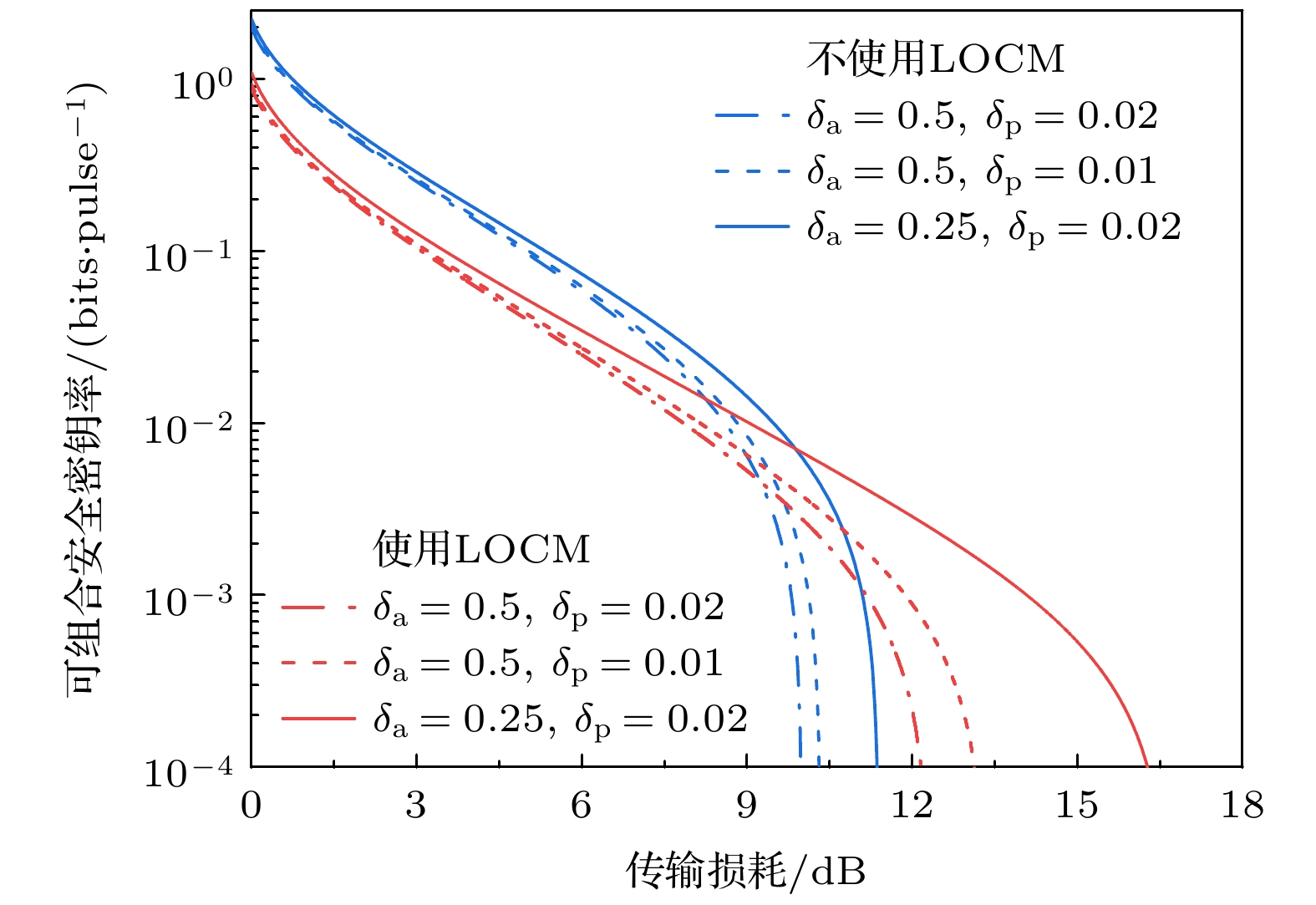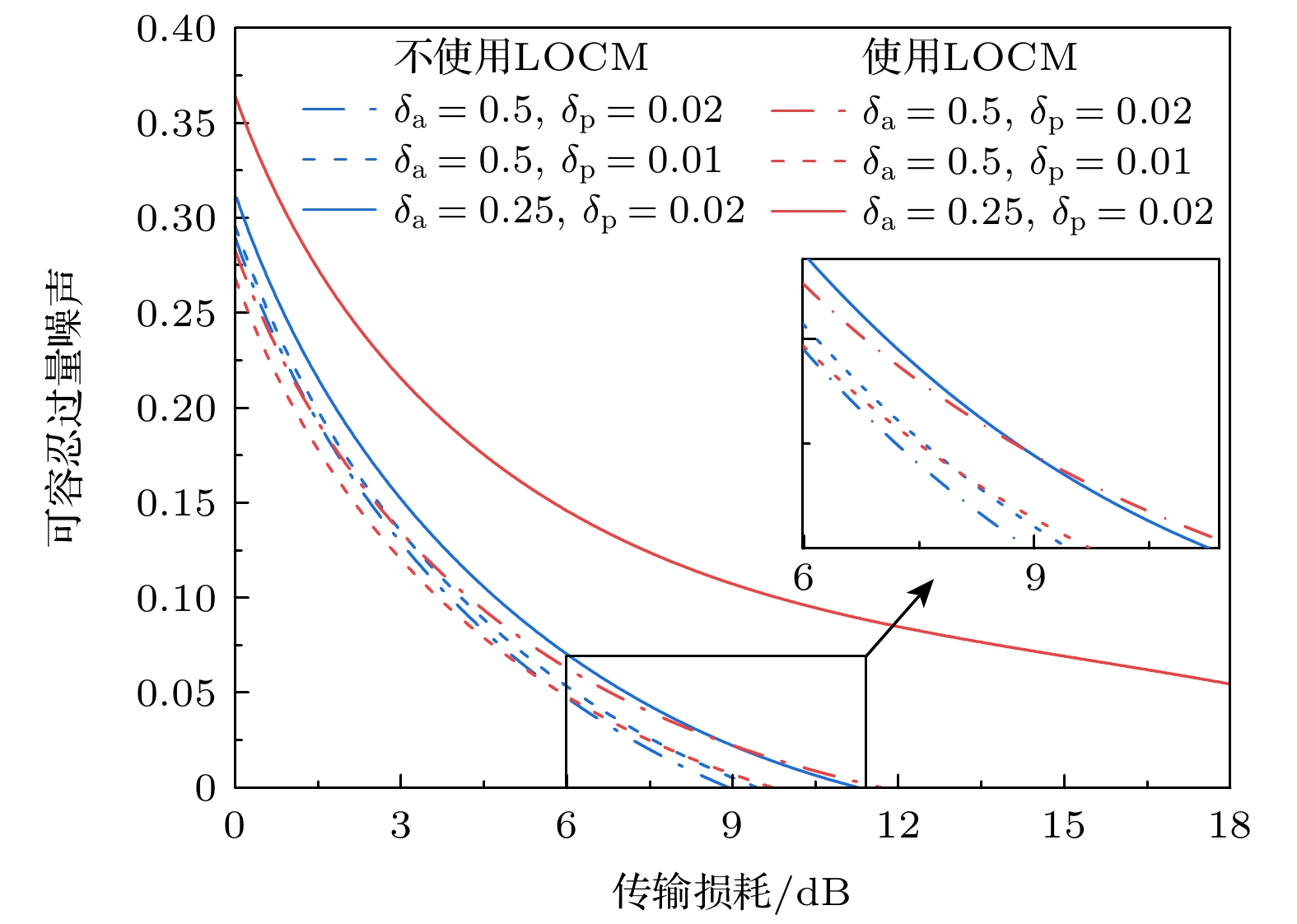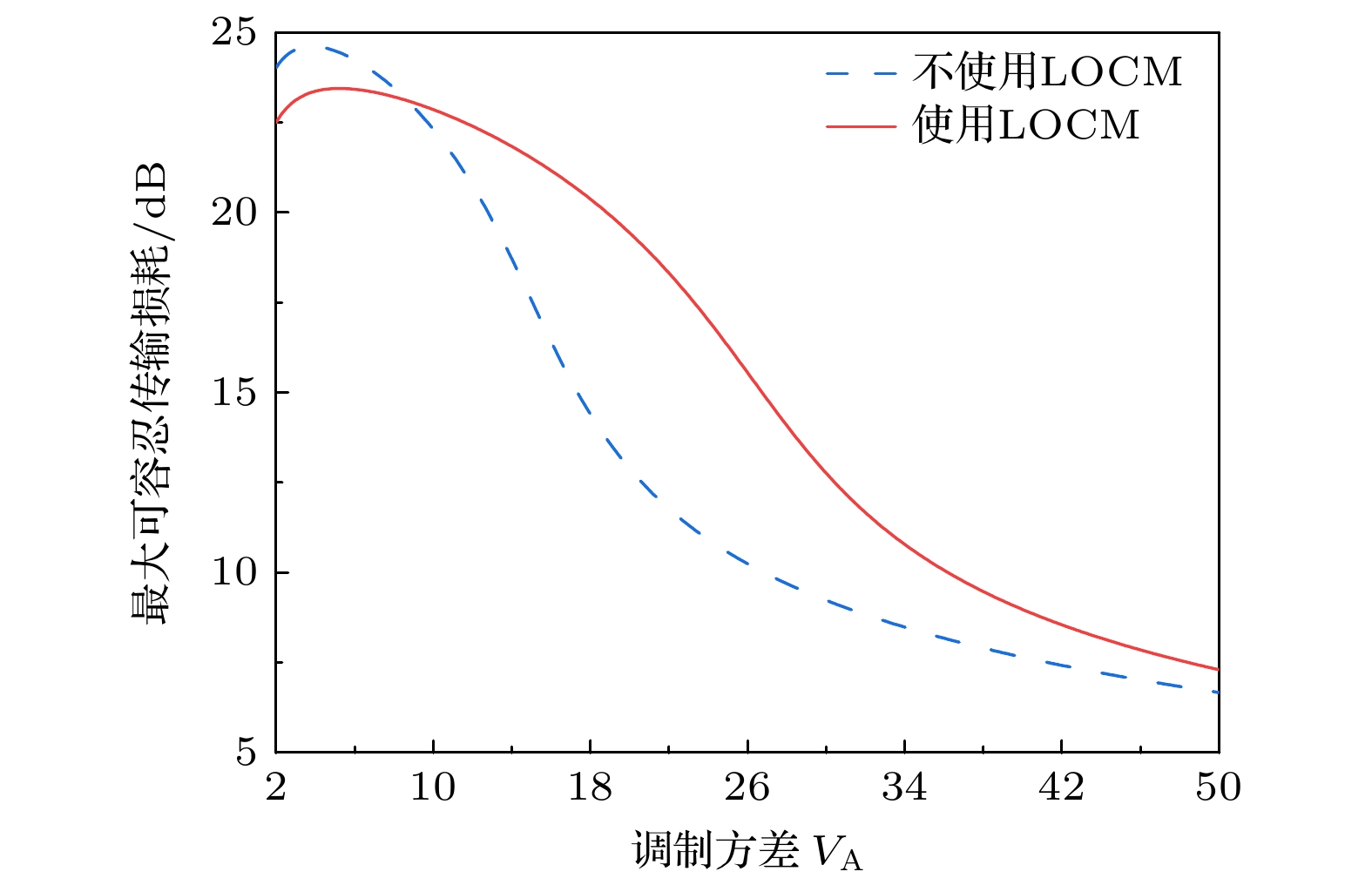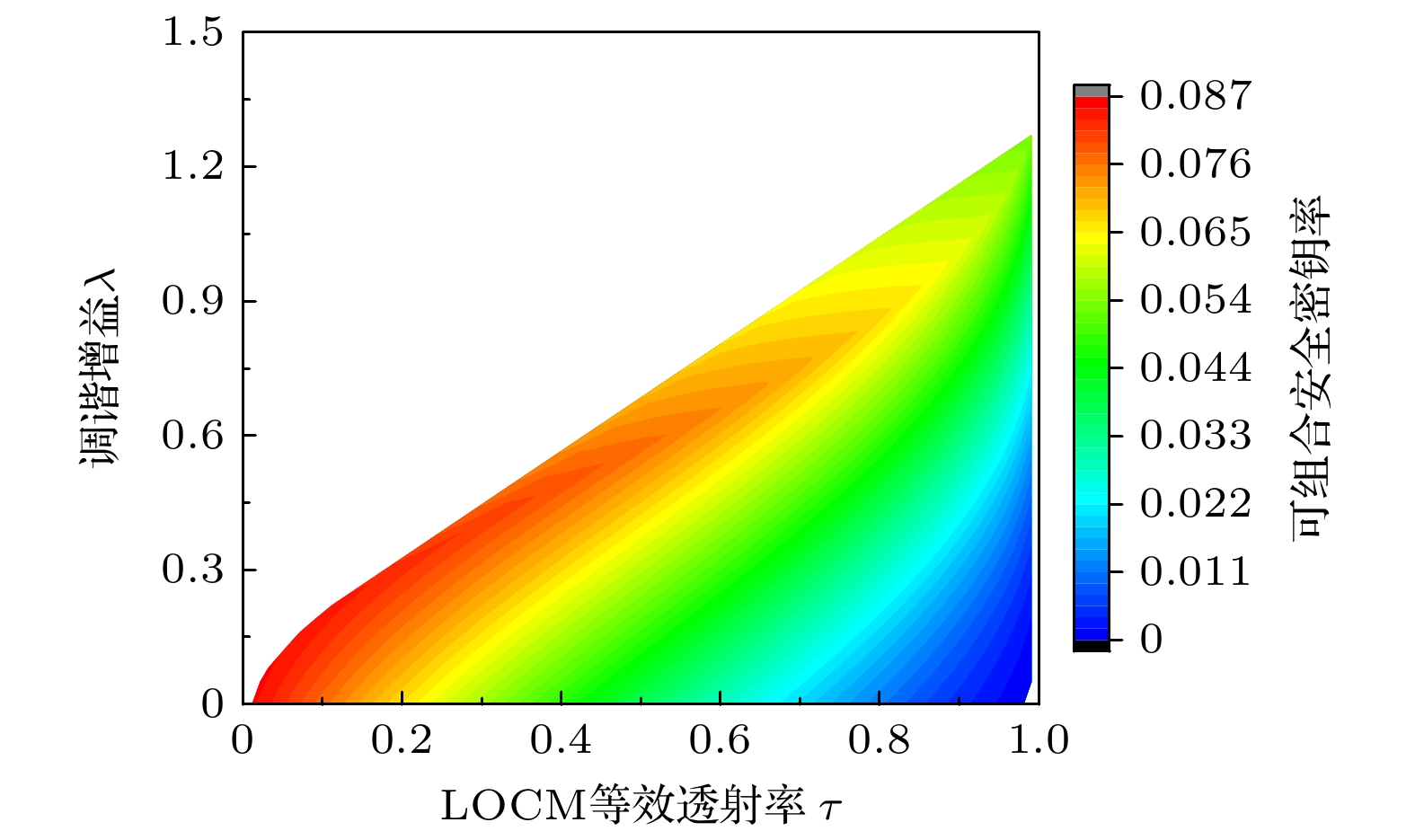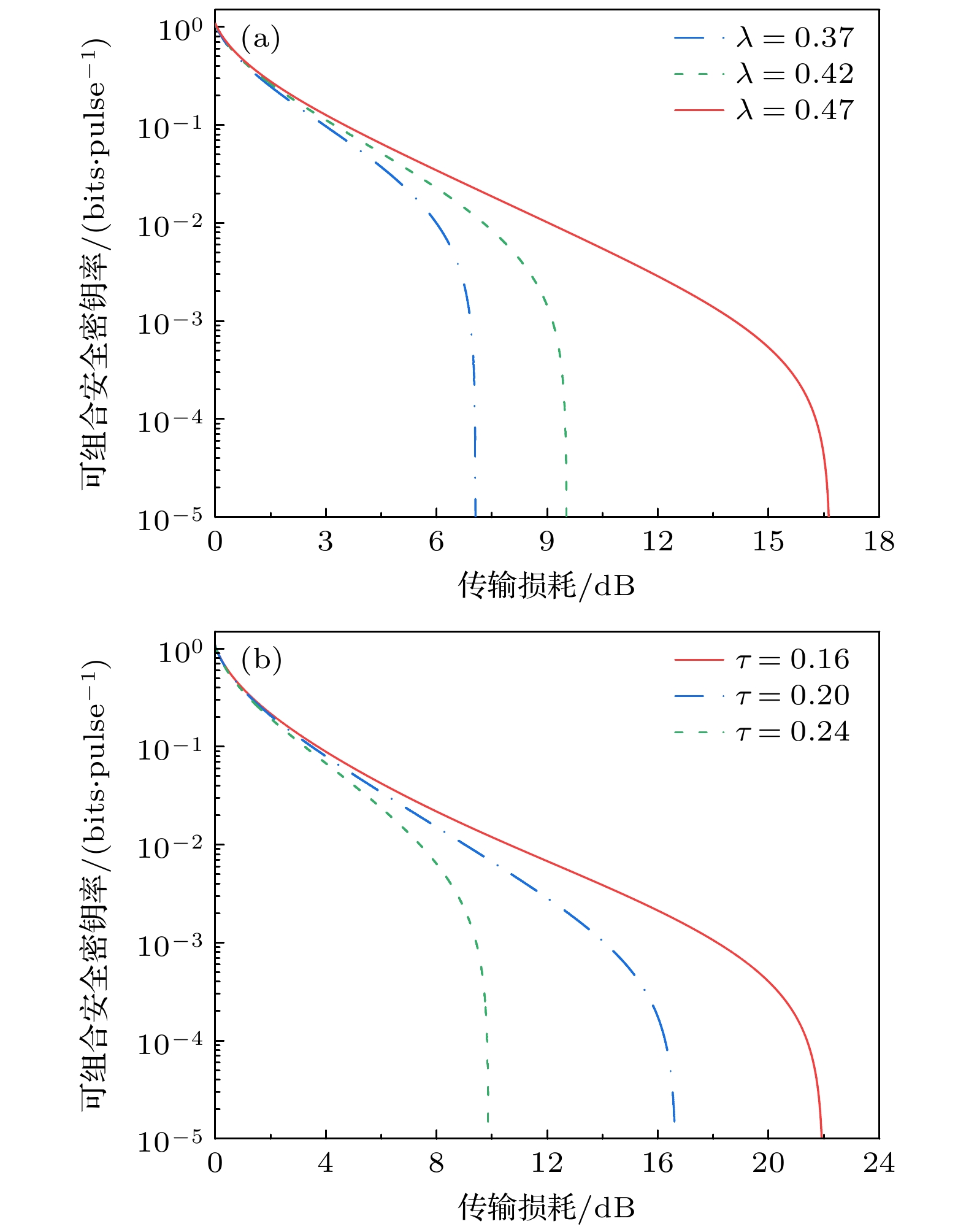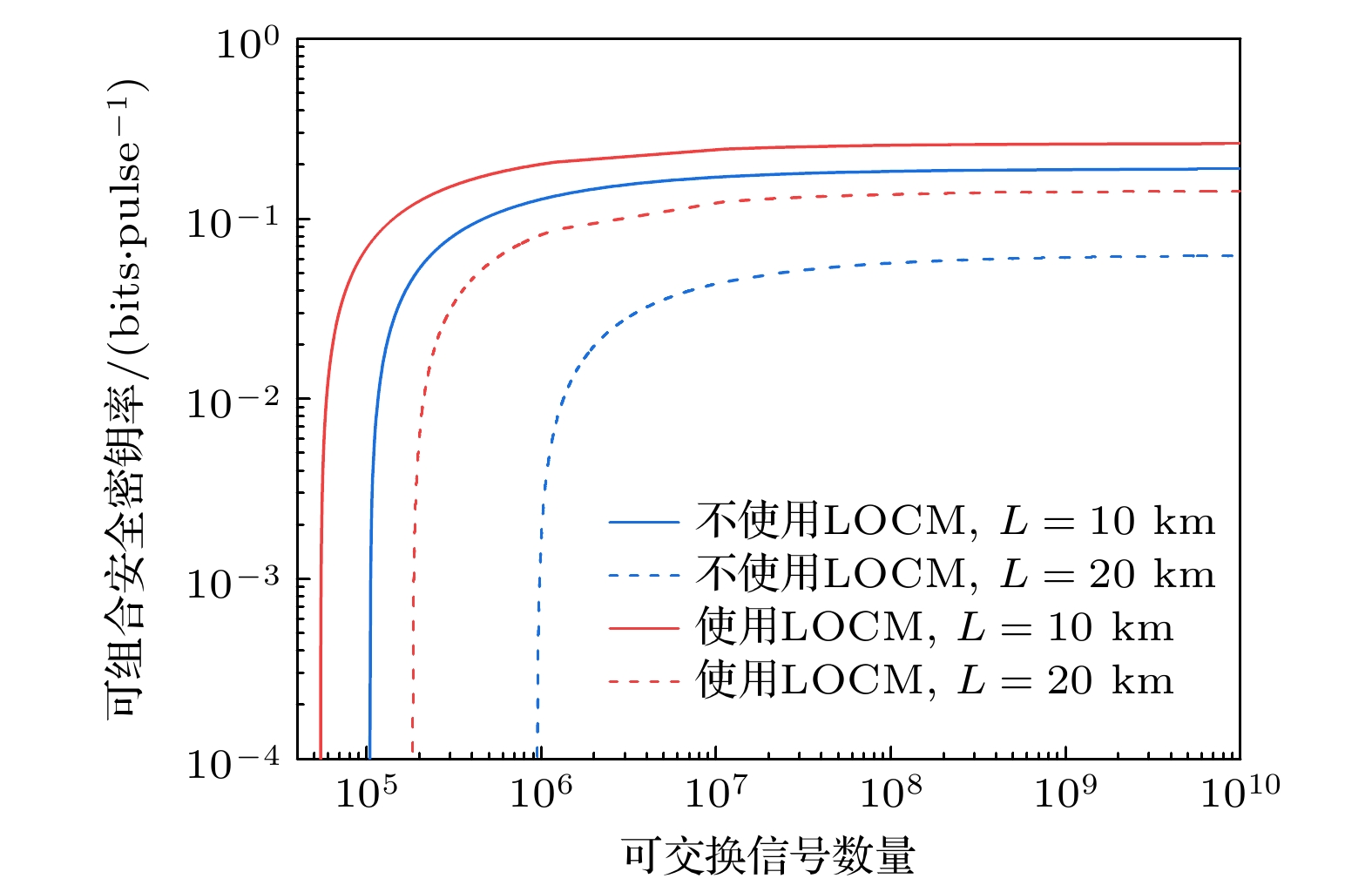-
In experimental setups of continuous-variable quantum key distribution (CVQKD) independently modulating the amplitude and phase of coherent states, the ideal Gaussian modulation will be degraded into discretized polar modulation (DPM) due to the finite resolution of the driving voltages of electro-optical modulators. To compensate for the performance degradation induced by the joint effect of amplitude and phase discretization, linear optics cloning machine (LOCM) can be introduced on the receiver side. Implemented by linear optical elements, heterodyne detection and controlled displacement, LOCM introduces extra noise that can be transformed into an advantageous one to combat channel excess noise by dynamically adjusting the relevant parameters into a suitable range. In this paper, the prepare-and-measure version of LOCM DPM-CVQKD is presented, where the incoming signal state enters a tunable LOCM before being measured by the nonideal heterodyne detector. The equivalent entanglement-based model is also established to perform security analysis, where the LOCM is reformulated into combination of the incoming signal state and a thermal state on a beam splitter. The composable secret key rate is derived to investigate the security of LOCM DPM-CVQKD. Simulation results demonstrate that the composable secret key rate and transmission distance are closely related to the tuning gain and the transmittance of LOCM. Once these two parameters are set to appropriate values, LOCM can improve the secret key rate and transmission distance of DPM-CVQKD, as well as its resistance to excess noise. Meanwhile, taking finite-size effect into consideration, the LOCM can also effectively reduce the requirement for the block size of the exchanged signals, which is beneficial to the feasibility and practicability of CVQKD. Owing to the fact that the performance of LOCM DPM-CVQKD is largely reliant on the calibration selection of relevant parameters, further research may concentrate on the optimization of LOCM in experimental implementations, where machine learning related methods may be utilized.
-
Keywords:
- quantum key distribution /
- continuous variable /
- discretized polar modulation /
- linear optics cloning machine
[1] Portmann C, Renner R 2022 Rev. Mod. Phys. 94 025008
 Google Scholar
Google Scholar
[2] Pirandola S, Andersen U L, Banchi L, Berta M, Bunandar D, Colbeck R, Englund D, Gehring T, Lupo C, Ottaviani C, Pereira J L, Razavi M, Shaari J S, Tomamichel M, Usenko V C, Vallone G, Villoresi P, Wallden P 2020 Adv. Opt. Photonics 12 1012
 Google Scholar
Google Scholar
[3] Zhang C X, Wu D, Cui P W, Ma J C, Wang Y, An J M 2023 Chin. Phys. B 32 124207
 Google Scholar
Google Scholar
[4] Zapatero V, Navarrete A, Curty M 2024 Adv. Quantum Technol. 202300380
[5] Diamanti E, Leverrier A 2015 Entropy 17 6072
 Google Scholar
Google Scholar
[6] Laudenbach F, Pacher C, Fung C H F, Poppe A, Peev M, Schrenk B, Hentschel M, Walther P, Hubel H 2018 Adv. Quantum Technol. 1 1800011
 Google Scholar
Google Scholar
[7] Guo H, Li Z, Yu S, Zhang Y C 2021 Fundam. Res. 1 96
 Google Scholar
Google Scholar
[8] Zhang Y C, Bian Y M, Li Z Y, Yu S 2024 Appl. Phys. Rev. 11 011318
 Google Scholar
Google Scholar
[9] Leverrier A 2015 Phys. Rev. Lett. 114 070501
 Google Scholar
Google Scholar
[10] Leverrier A 2017 Phys. Rev. Lett. 118 200501
 Google Scholar
Google Scholar
[11] Zhang Y C, Li Z Y, Chen Z Y, Weedbrook C; Zhao Y J, Wang X Y, Huang Y D, Xu C C, Zhang X X, Wang Z Y, Li M, Zhang X Y, Zheng Z Y, Chu B J, Gao X Y, Meng N, Cai W W, Wang Z, Wang G, Yu S, Guo H 2019 Quantum Sci. Technol. 4 035006
 Google Scholar
Google Scholar
[12] Zhang Y C, Chen Z Y, Pirandola S, Wang X Y, Zhou C, Chu B J, Zhao Y J, Xu B J, Yu S, Guo H 2020 Phys. Rev. Lett. 125 010502
 Google Scholar
Google Scholar
[13] Jain N, Chin H M, Mani H, Lupo C, Nikolic D S, Kordts A, Pirandola S, Pedersen T B, Kolb M, Omer B, Pacher C, Gehring T, Andersen U L 2022 Nat. Commun. 13 4740
 Google Scholar
Google Scholar
[14] Hajomer A A E, Derkach I, Jain N, Chin H M, Andersen U L, Gehring T 2024 Sci. Adv. 10 eadi9474
 Google Scholar
Google Scholar
[15] Wang T, Huang P, Li L, Zhou Y M, Zeng G H 2024 New J. Phys. 26 023002
 Google Scholar
Google Scholar
[16] 廖骎, 柳海杰, 王铮, 朱凌瑾 2023 物理学报 72 040301
 Google Scholar
Google Scholar
Liao Q, Liu H J, Wang Z, Zhu L J 2023 Acta Phys. Sin. 72 040301
 Google Scholar
Google Scholar
[17] Chen Z Y, Wang X Y, Yu S, Li Z Y, Guo H 2023 npj Quantum Inf. 9 28
 Google Scholar
Google Scholar
[18] Zheng Y, Wang Y L, Fang C L, Shi H B, Pan W 2024 Phys. Rev. A 109 022424
 Google Scholar
Google Scholar
[19] 张光伟, 白建东, 颉琦, 靳晶晶, 张永梅, 刘文元 2024 物理学报 73 060301
 Google Scholar
Google Scholar
Zhang G W, Bai J D, Jie Q, Jin J J, Zhang Y M, Liu W Y 2024 Acta Phys. Sin. 73 060301
 Google Scholar
Google Scholar
[20] Jouguet P, Kunz-Jacques S, Diamanti E, Leverrier A 2012 Phys. Rev. A 86 032309
 Google Scholar
Google Scholar
[21] 吴晓东, 黄端, 黄鹏, 郭迎 2022 物理学报 71 240304.
 Google Scholar
Google Scholar
Wu X D, Huang D, Huang P, Guo Y, 2022 Acta Phys. Sin. 71 240304
 Google Scholar
Google Scholar
[22] 张云杰, 王旭阳, 张瑜, 王宁, 贾雁翔, 史玉琪, 卢振国, 邹俊, 李永民 2024 物理学报 73 060302
 Google Scholar
Google Scholar
Zhang Y J, Wang X Y, Zhang Y, Wang N, Jia Y X, Shi Y Q, Lu Z G, Zou J, Li Y M 2024 Acta Phys. Sin. 73 060302
 Google Scholar
Google Scholar
[23] Lupo C 2020 Phys. Rev. A 102 022623
 Google Scholar
Google Scholar
[24] Wang T Y, Li M, Wang X 2022 Opt. Express 30 36122
 Google Scholar
Google Scholar
[25] Wang T Y, Li M, Wang X, Hou L 2023 Opt. Express 31 21014
 Google Scholar
Google Scholar
[26] Guo Y, Lv G, Zeng G H 2015 Quantum Inf. Process. 14 4323
 Google Scholar
Google Scholar
[27] Wu X D, Liao Q, Huang D, Wu X H, Guo Y 2017 Chin. Phys. B 26 110304
 Google Scholar
Google Scholar
[28] Zhang H, Mao Y, Huang D, Guo Y, Wu X D, Zhang L 2018 Chin. Phys. B 27 090307
 Google Scholar
Google Scholar
[29] Yang F L, Qiu D W 2020 Quantum Inf. Process. 19 99
 Google Scholar
Google Scholar
[30] He Y, Wang T Y 2024 Quantum Inf Process. 23 135
 Google Scholar
Google Scholar
[31] Mao Y Y, Wang Y J, Guo Y, Mao Y H, Huang W T 2021 Acta Phys. Sin. 70 110302 [毛宜钰, 王一军, 郭迎, 毛堉昊, 黄文体 2021 物理学报 70 110302]
 Google Scholar
Google Scholar
Mao Y Y, Wang Y J, Guo Y, Mao Y H, Huang W T 2021 Acta Phys. Sin. 70 110302
 Google Scholar
Google Scholar
[32] 吴晓东, 黄端 2023 物理学报 72 050303
 Google Scholar
Google Scholar
Wu X D, Huang D 2023 Acta Phys. Sin. 72 050303
 Google Scholar
Google Scholar
[33] Stefano P 2021 Phys. Rev. Res. 3 013279
 Google Scholar
Google Scholar
[34] Pirandola S 2021 Phys. Rev. Res. 3 043014
 Google Scholar
Google Scholar
[35] Mountogiannakis A G, Papanastasiou P, Pirandola S 2022 Phys. Rev. A 106 042606
 Google Scholar
Google Scholar
[36] Liu J Y, Ding H J, Zhang C M, Xie S P, Wang Q 2019 Phys. Rev. Appl. 12 014059
 Google Scholar
Google Scholar
[37] Liu J Y, Jiang Q Q, Ding H J, Ma X, Sun M S, Xu J X, Zhang C H, Xie S P, Li J, Zeng G H, Zhou X Y, Wang Q 2023 Sci. China Inf. Sci. 66 189402
 Google Scholar
Google Scholar
[38] Zhang Z K, Liu W Q, Qi J, He C, Huang P 2023 Phys. Rev. A 107 062614
 Google Scholar
Google Scholar
[39] Chin H M, Jain N, Zibar D, Andersen U L, Gehring T 2021 npj Quantum Inf. 7 20
 Google Scholar
Google Scholar
[40] Xu J X, Ma X, Liu J Y, Zhang C H, Li H W, Zhou X Y, Wang Q 2024 Sci. China Inf. Sci. 67 202501
 Google Scholar
Google Scholar
-
图 5 调制方差对最大传输距离的影响, 幅值分辨率和相位分辨率分别设置为${\delta _{\text{a}}} = 0.25$, ${\delta _{\text{p}}} = 0.02$
Figure 5. The effect of modulation variance on maximum transmission distance, the amplitude resolution and phase resolution are ${\delta _{\text{a}}} = 0.25$, ${\delta _{\text{p}}} = 0.02$, respectively.
图 6 LOCM参数对可组合安全密钥率的影响, 幅值分辨率和相位分辨率分别设置为${\delta _{\text{a}}} = 0.25$, ${\delta _{\text{p}}} = 0.02$
Figure 6. Effect of LOCM-related parameters on the composable secret key rate, the amplitude resolution and phase resolution are ${\delta _{\text{a}}} = 0.25$, ${\delta _{\text{p}}} = 0.02$, respectively.
图 7 LOCM参数对最大传输距离的影响, 幅值分辨率和相位分辨率分别设置为${\delta _{\text{a}}} = 0.25$, ${\delta _{\text{p}}} = 0.02$ (a)调谐增益$\lambda $与传输损耗的关系; (b)等效透射率$\tau $与传输损耗的关系
Figure 7. Effect of LOCM parameters on maximum transmission distance, the amplitude resolution and phase resolution are set to ${\delta _{\text{a}}} = 0.25$, ${\delta _{\text{p}}} = 0.02$, respectively: (a) The tuning gain $\lambda $ versus losses; (b) the equivalent transmittance $\tau $ versus losses.
图 8 不同传输距离下码长对可组合安全密钥率的影响, 幅值分辨率和相位分辨率分别设置为${\delta _{\text{a}}} = 0.25$, ${\delta _{\text{p}}} = 0.02$
Figure 8. Effect of block length on the composable secret key rate under different transmission distances, the amplitude resolution and phase resolution are set to ${\delta _{\text{a}}} = 0.25$, ${\delta _{\text{p}}} = 0.02$, respectively.
-
[1] Portmann C, Renner R 2022 Rev. Mod. Phys. 94 025008
 Google Scholar
Google Scholar
[2] Pirandola S, Andersen U L, Banchi L, Berta M, Bunandar D, Colbeck R, Englund D, Gehring T, Lupo C, Ottaviani C, Pereira J L, Razavi M, Shaari J S, Tomamichel M, Usenko V C, Vallone G, Villoresi P, Wallden P 2020 Adv. Opt. Photonics 12 1012
 Google Scholar
Google Scholar
[3] Zhang C X, Wu D, Cui P W, Ma J C, Wang Y, An J M 2023 Chin. Phys. B 32 124207
 Google Scholar
Google Scholar
[4] Zapatero V, Navarrete A, Curty M 2024 Adv. Quantum Technol. 202300380
[5] Diamanti E, Leverrier A 2015 Entropy 17 6072
 Google Scholar
Google Scholar
[6] Laudenbach F, Pacher C, Fung C H F, Poppe A, Peev M, Schrenk B, Hentschel M, Walther P, Hubel H 2018 Adv. Quantum Technol. 1 1800011
 Google Scholar
Google Scholar
[7] Guo H, Li Z, Yu S, Zhang Y C 2021 Fundam. Res. 1 96
 Google Scholar
Google Scholar
[8] Zhang Y C, Bian Y M, Li Z Y, Yu S 2024 Appl. Phys. Rev. 11 011318
 Google Scholar
Google Scholar
[9] Leverrier A 2015 Phys. Rev. Lett. 114 070501
 Google Scholar
Google Scholar
[10] Leverrier A 2017 Phys. Rev. Lett. 118 200501
 Google Scholar
Google Scholar
[11] Zhang Y C, Li Z Y, Chen Z Y, Weedbrook C; Zhao Y J, Wang X Y, Huang Y D, Xu C C, Zhang X X, Wang Z Y, Li M, Zhang X Y, Zheng Z Y, Chu B J, Gao X Y, Meng N, Cai W W, Wang Z, Wang G, Yu S, Guo H 2019 Quantum Sci. Technol. 4 035006
 Google Scholar
Google Scholar
[12] Zhang Y C, Chen Z Y, Pirandola S, Wang X Y, Zhou C, Chu B J, Zhao Y J, Xu B J, Yu S, Guo H 2020 Phys. Rev. Lett. 125 010502
 Google Scholar
Google Scholar
[13] Jain N, Chin H M, Mani H, Lupo C, Nikolic D S, Kordts A, Pirandola S, Pedersen T B, Kolb M, Omer B, Pacher C, Gehring T, Andersen U L 2022 Nat. Commun. 13 4740
 Google Scholar
Google Scholar
[14] Hajomer A A E, Derkach I, Jain N, Chin H M, Andersen U L, Gehring T 2024 Sci. Adv. 10 eadi9474
 Google Scholar
Google Scholar
[15] Wang T, Huang P, Li L, Zhou Y M, Zeng G H 2024 New J. Phys. 26 023002
 Google Scholar
Google Scholar
[16] 廖骎, 柳海杰, 王铮, 朱凌瑾 2023 物理学报 72 040301
 Google Scholar
Google Scholar
Liao Q, Liu H J, Wang Z, Zhu L J 2023 Acta Phys. Sin. 72 040301
 Google Scholar
Google Scholar
[17] Chen Z Y, Wang X Y, Yu S, Li Z Y, Guo H 2023 npj Quantum Inf. 9 28
 Google Scholar
Google Scholar
[18] Zheng Y, Wang Y L, Fang C L, Shi H B, Pan W 2024 Phys. Rev. A 109 022424
 Google Scholar
Google Scholar
[19] 张光伟, 白建东, 颉琦, 靳晶晶, 张永梅, 刘文元 2024 物理学报 73 060301
 Google Scholar
Google Scholar
Zhang G W, Bai J D, Jie Q, Jin J J, Zhang Y M, Liu W Y 2024 Acta Phys. Sin. 73 060301
 Google Scholar
Google Scholar
[20] Jouguet P, Kunz-Jacques S, Diamanti E, Leverrier A 2012 Phys. Rev. A 86 032309
 Google Scholar
Google Scholar
[21] 吴晓东, 黄端, 黄鹏, 郭迎 2022 物理学报 71 240304.
 Google Scholar
Google Scholar
Wu X D, Huang D, Huang P, Guo Y, 2022 Acta Phys. Sin. 71 240304
 Google Scholar
Google Scholar
[22] 张云杰, 王旭阳, 张瑜, 王宁, 贾雁翔, 史玉琪, 卢振国, 邹俊, 李永民 2024 物理学报 73 060302
 Google Scholar
Google Scholar
Zhang Y J, Wang X Y, Zhang Y, Wang N, Jia Y X, Shi Y Q, Lu Z G, Zou J, Li Y M 2024 Acta Phys. Sin. 73 060302
 Google Scholar
Google Scholar
[23] Lupo C 2020 Phys. Rev. A 102 022623
 Google Scholar
Google Scholar
[24] Wang T Y, Li M, Wang X 2022 Opt. Express 30 36122
 Google Scholar
Google Scholar
[25] Wang T Y, Li M, Wang X, Hou L 2023 Opt. Express 31 21014
 Google Scholar
Google Scholar
[26] Guo Y, Lv G, Zeng G H 2015 Quantum Inf. Process. 14 4323
 Google Scholar
Google Scholar
[27] Wu X D, Liao Q, Huang D, Wu X H, Guo Y 2017 Chin. Phys. B 26 110304
 Google Scholar
Google Scholar
[28] Zhang H, Mao Y, Huang D, Guo Y, Wu X D, Zhang L 2018 Chin. Phys. B 27 090307
 Google Scholar
Google Scholar
[29] Yang F L, Qiu D W 2020 Quantum Inf. Process. 19 99
 Google Scholar
Google Scholar
[30] He Y, Wang T Y 2024 Quantum Inf Process. 23 135
 Google Scholar
Google Scholar
[31] Mao Y Y, Wang Y J, Guo Y, Mao Y H, Huang W T 2021 Acta Phys. Sin. 70 110302 [毛宜钰, 王一军, 郭迎, 毛堉昊, 黄文体 2021 物理学报 70 110302]
 Google Scholar
Google Scholar
Mao Y Y, Wang Y J, Guo Y, Mao Y H, Huang W T 2021 Acta Phys. Sin. 70 110302
 Google Scholar
Google Scholar
[32] 吴晓东, 黄端 2023 物理学报 72 050303
 Google Scholar
Google Scholar
Wu X D, Huang D 2023 Acta Phys. Sin. 72 050303
 Google Scholar
Google Scholar
[33] Stefano P 2021 Phys. Rev. Res. 3 013279
 Google Scholar
Google Scholar
[34] Pirandola S 2021 Phys. Rev. Res. 3 043014
 Google Scholar
Google Scholar
[35] Mountogiannakis A G, Papanastasiou P, Pirandola S 2022 Phys. Rev. A 106 042606
 Google Scholar
Google Scholar
[36] Liu J Y, Ding H J, Zhang C M, Xie S P, Wang Q 2019 Phys. Rev. Appl. 12 014059
 Google Scholar
Google Scholar
[37] Liu J Y, Jiang Q Q, Ding H J, Ma X, Sun M S, Xu J X, Zhang C H, Xie S P, Li J, Zeng G H, Zhou X Y, Wang Q 2023 Sci. China Inf. Sci. 66 189402
 Google Scholar
Google Scholar
[38] Zhang Z K, Liu W Q, Qi J, He C, Huang P 2023 Phys. Rev. A 107 062614
 Google Scholar
Google Scholar
[39] Chin H M, Jain N, Zibar D, Andersen U L, Gehring T 2021 npj Quantum Inf. 7 20
 Google Scholar
Google Scholar
[40] Xu J X, Ma X, Liu J Y, Zhang C H, Li H W, Zhou X Y, Wang Q 2024 Sci. China Inf. Sci. 67 202501
 Google Scholar
Google Scholar
Catalog
Metrics
- Abstract views: 2705
- PDF Downloads: 51
- Cited By: 0















 DownLoad:
DownLoad:

